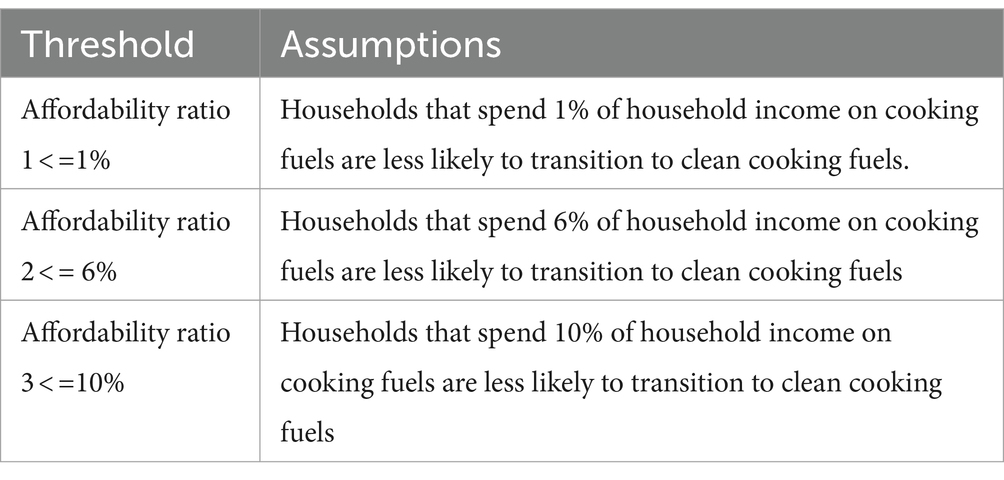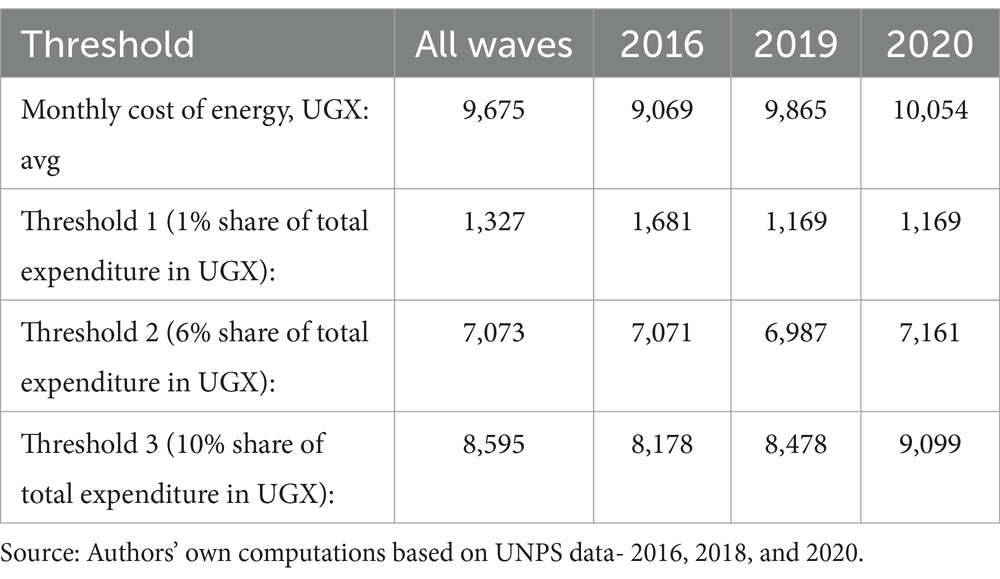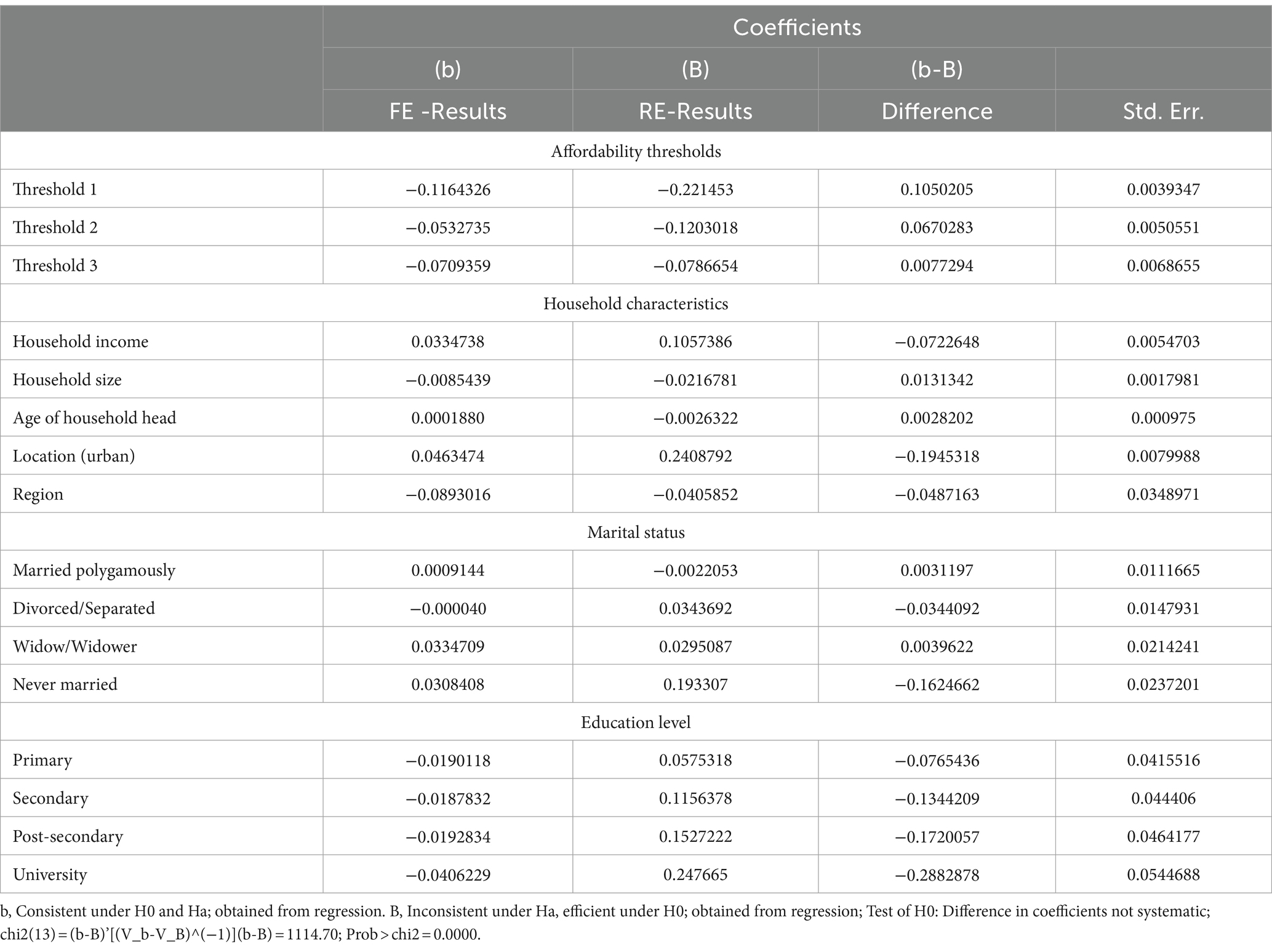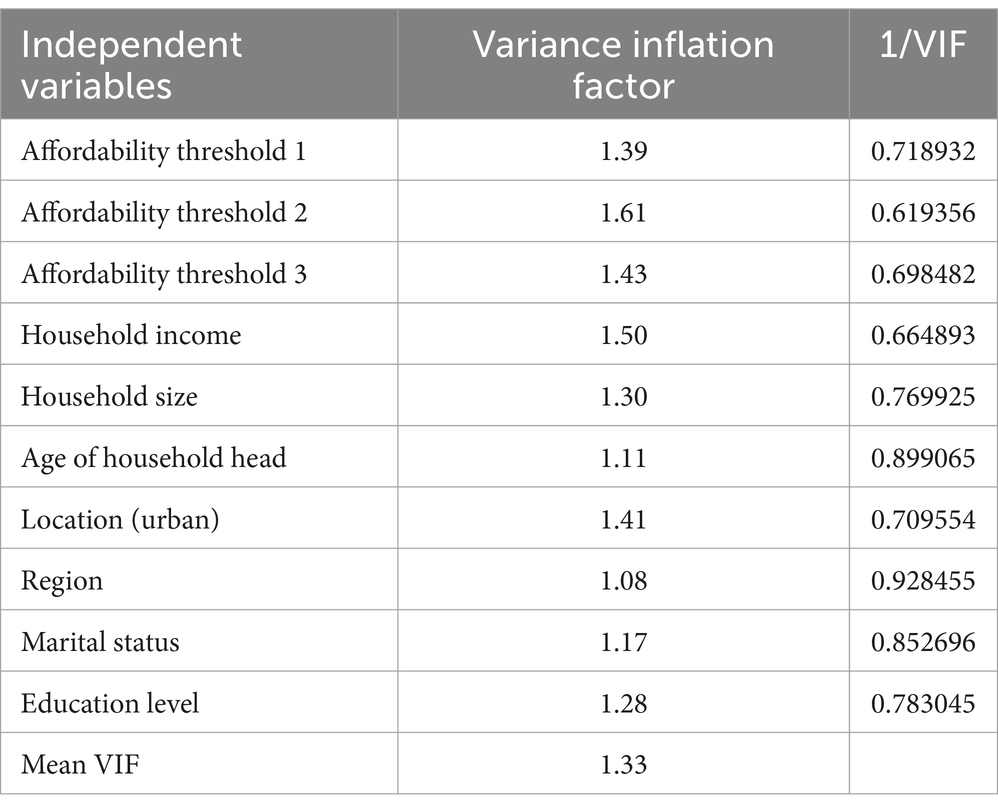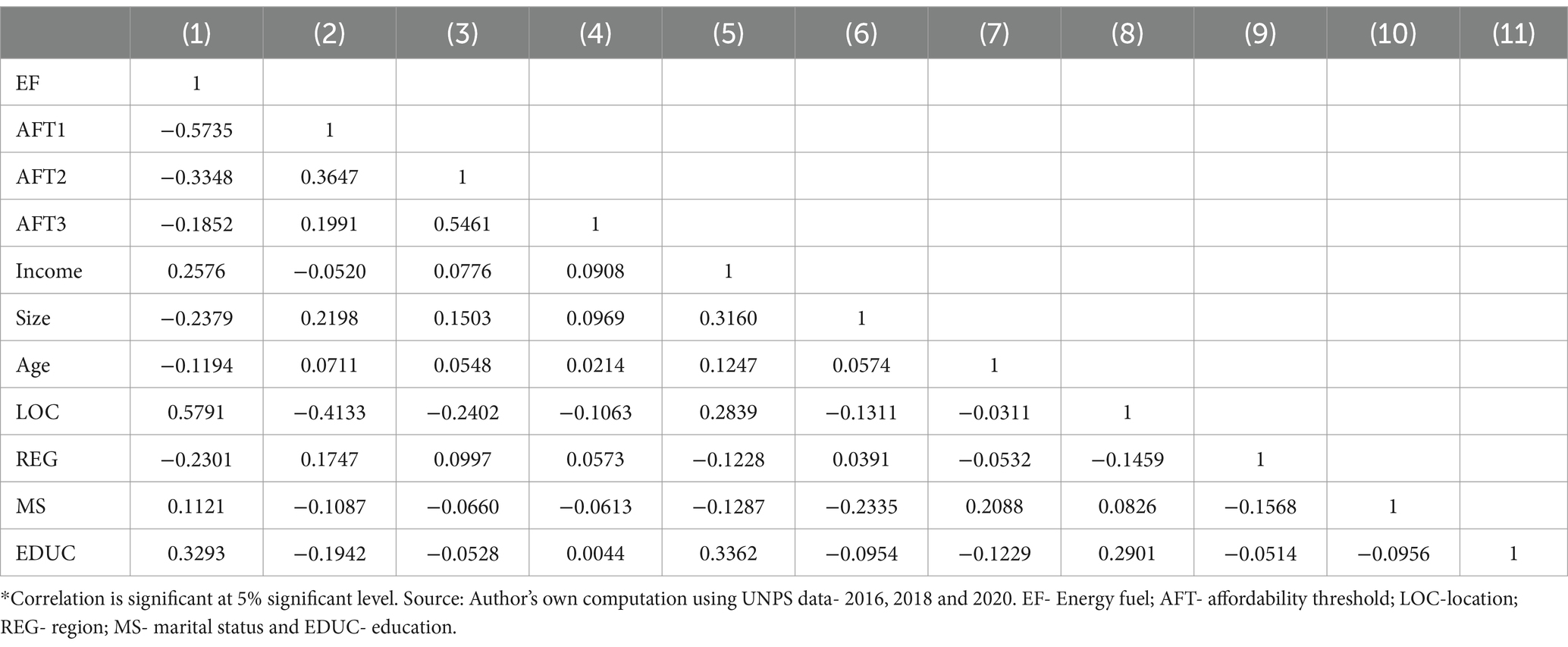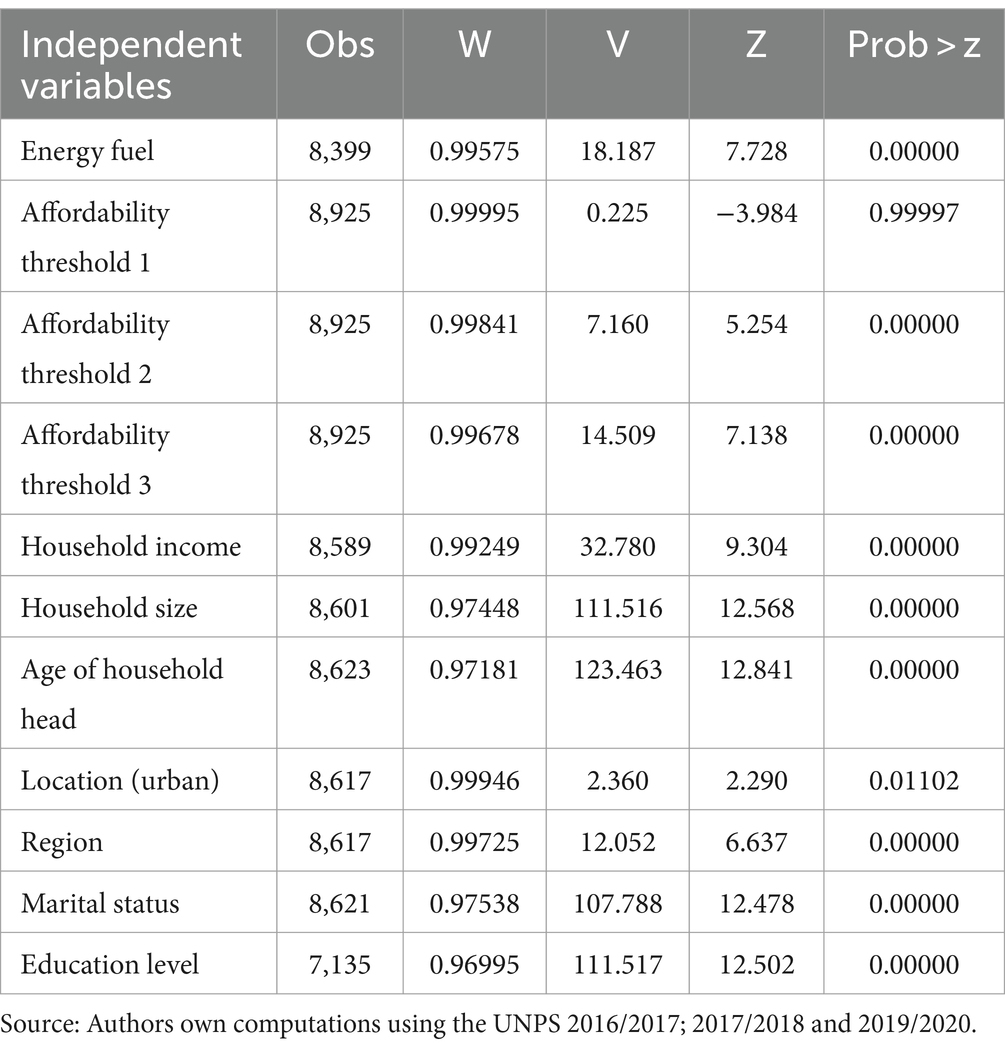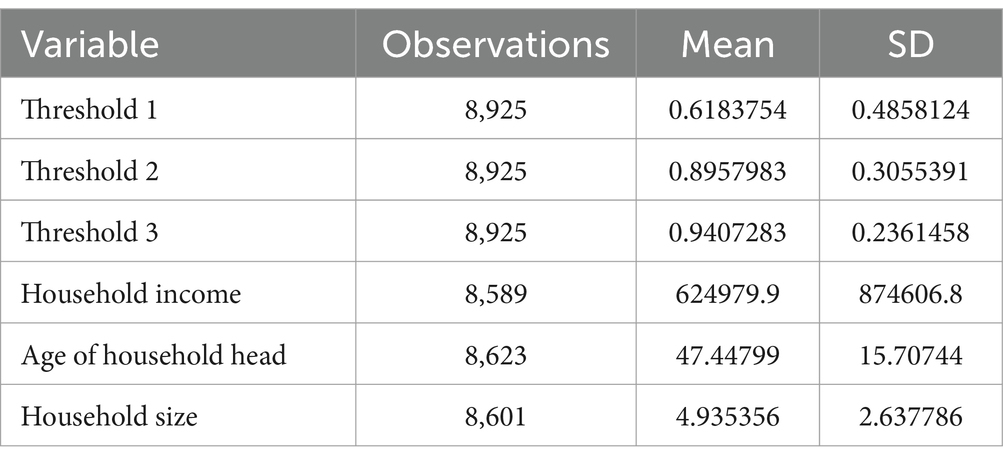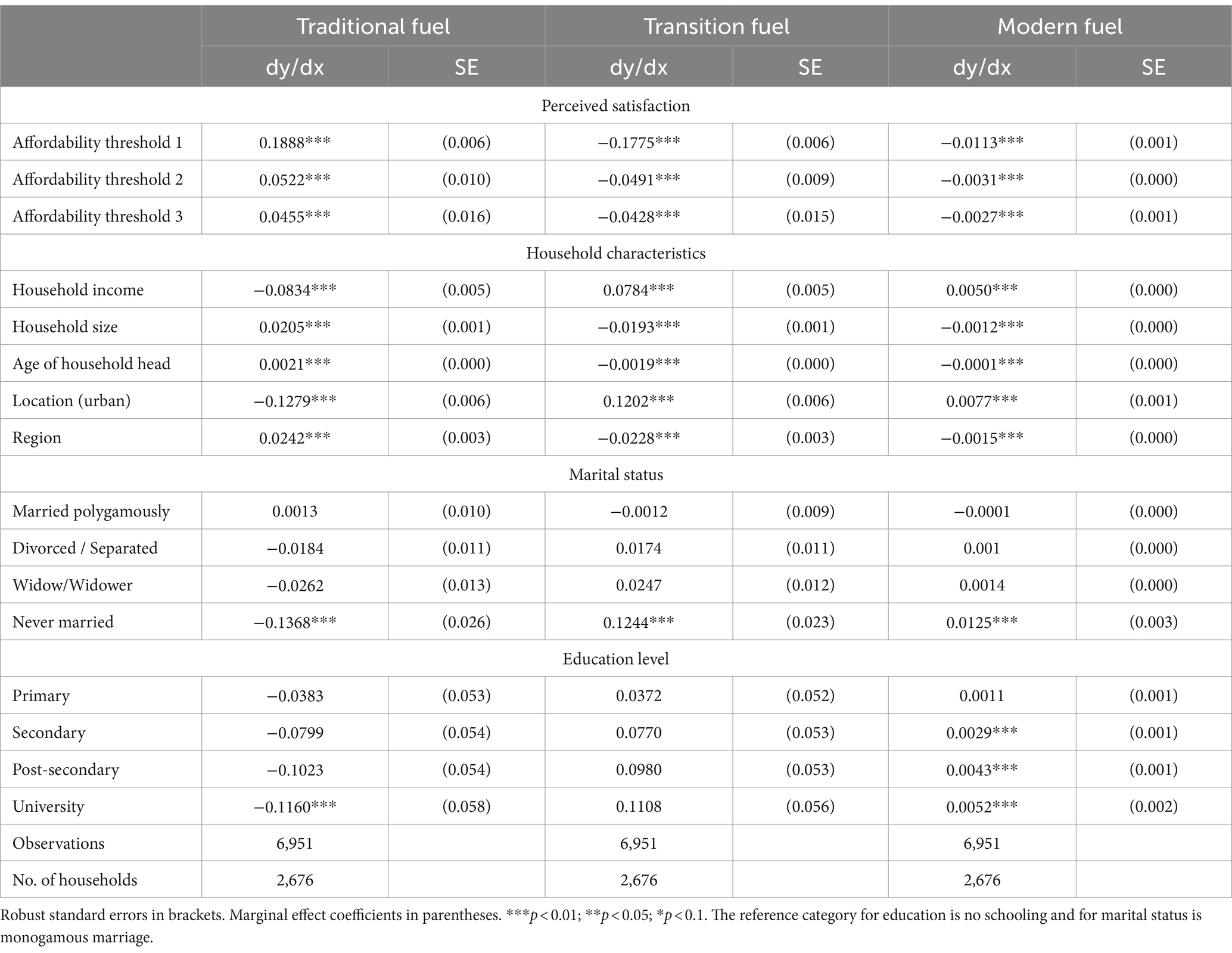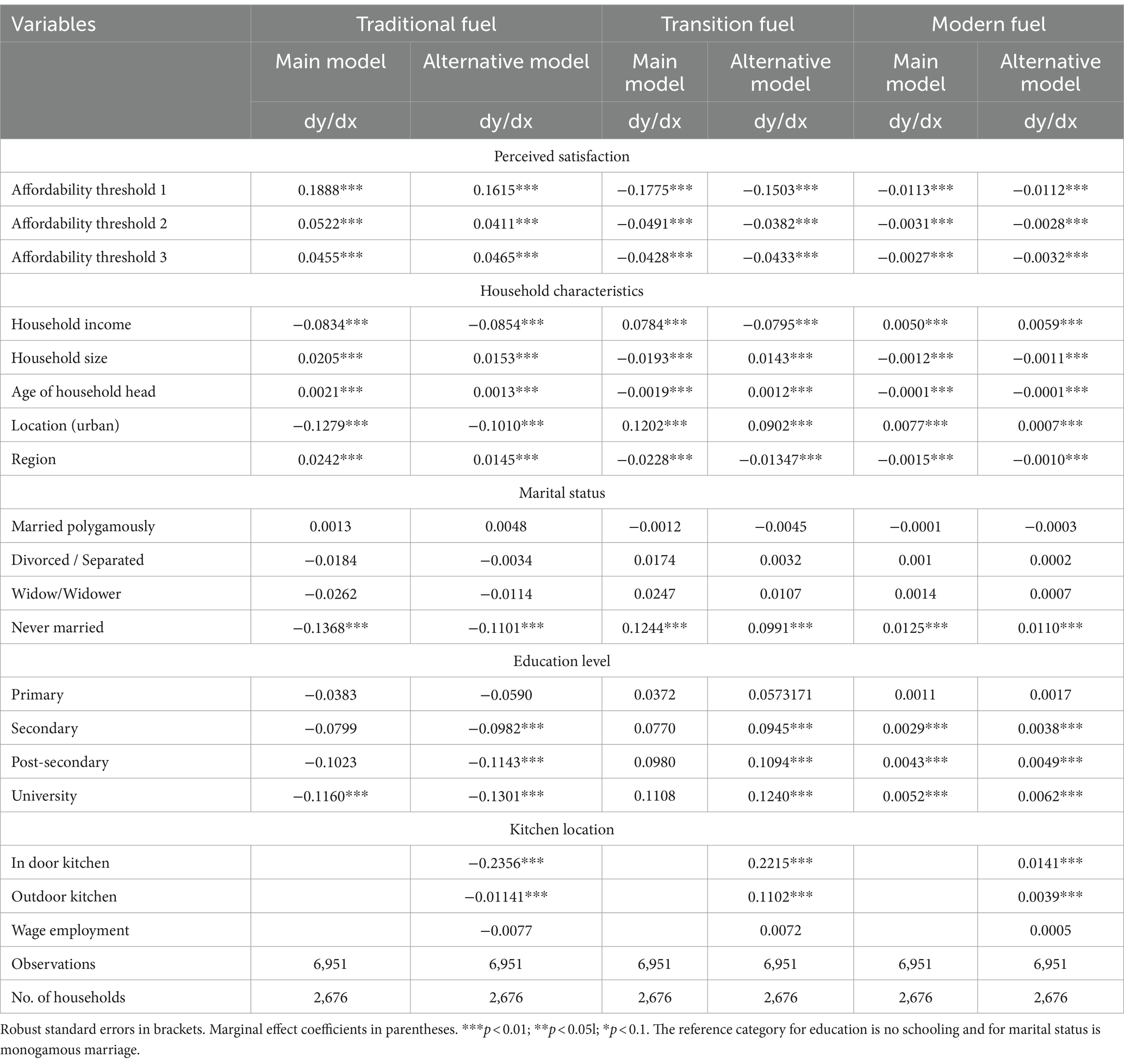- 1Faculty of Economics, Energy and Management Science, Makerere University Business School, Kampala, Uganda
- 2School of Economics, College of Business and Management Studies, Makerere University, Kampala, Uganda
- 3Faculty of Business Administration, Makerere University, Kampala, Uganda
Introduction: The dominance of biomass for cooking has implications for the country. For instance, biomass conversion using traditional technologies (three stone) in poorly ventilated kitchens produce smoke that influences the reproductive health outcomes for expectant mother. Beyond health outcomes, uncontrollable harvesting of biomass for cooking contributes to environmental degradation. Unfortunately, biomass in form of firewood, charcoal, plant and animal wastes is widely consumed by more than 94% of Ugandan households for cooking. This paper examined whether perceived satisfaction plays a significant role in household energy transition in Uganda.
Methods: The study adopted a panel data methodology employing an ordered logit model with random effects to estimate the effect of perceived satisfaction on household fuel transition from high to low pollutant cooking fuels in Uganda. The data used was obtained from Uganda Bureau of Statistics (UBoS) which is mandated by an Act of parliament to develop and maintain a national statistics system to ensure collection, analysis and publication of integrated, relevant, reliable and timely statistical information.
Findings and discussion: Our findings demonstrate that perceived satisfaction influences household fuel transition decisions in Uganda. The study concluded by suggesting policy recommendations for government action.
1 Background of the study
It is increasingly becoming undeniable that human activities including cooking practices using traditional and highly emitting fuels are affecting the climate (Wallace-Wells, 2019; Frankowska et al., 2020). As a result, many governments including Ugandan national government are prioritizing transition to less polluting fuels. Recently, the government of Uganda focused on increasing the percentage of clean cooking fuels from 15 to 50% by 2030 [National Planning Authority (NDPIII), 2020, 2020/21–2024/25]. Unfortunately, as of 2020, the number of households still using biomass for cooking stood at 94% (UBOS-UNHS, 2020). The dominance of biomass for cooking has implications for the country. For instance, biomass conversion using traditional technologies in poorly ventilated kitchens produce smoke that impacts negatively on human health (Bamwesigye et al., 2020). Beyond health outcomes, uncontrollable harvesting of biomass for cooking contributes to environmental degradation (Bamwesigye et al., 2020).
Aware of the challenges, government has put interventions to cab down the reliance on biomass for cooking. In recent developments, the government has taken extra mile to supply free liquified petroleum cylinders to households as a way of promoting the much-needed transition. Furthermore the introduction of Parish Development Model -PDM (Ministry of Local Government, 2021) has a component on clean cooking. Tax waivers on the importation of liquified petroleum gas have also been effected. Other policies aimed at promoting the use of clean cooking fuels include the last mile connection policy, Uganda rural electrification program. With all these interventions in place, only about 06% of the households are using clean cooking fuels in Uganda.
Perceived satisfaction has been identified as one of the barriers to household energy transition. Satisfaction relates to ones feeling of content or discontentment after comparing the product performance with expectations (Kotler et al., 2005; Jahanshahi et al., 2011). Consumers’ satisfaction or dissatisfaction with a given product influences the subsequent behavior toward the sustained use of a product. Conceptualizing energy fuel as a consumption good, households conduct their assessment based on indicators such as; reliability, affordability and performance in terms of time taken to cook, taste of food among others. Once households are contented with their assessment of the fuel and it is satisfying, they will be motivated to adopt such fuels for cooking (Baquié and Urpelainen, 2017).
In household energy transition studies (Malakar et al., 2018; Jürisoo et al., 2019; Ndunguru and Lema, 2021), households are reported to believe that food cooked using alternative fuels is not tasty as that prepared using traditional biomass fuel. Furthermore, the preposition that clean energy options like LPG cook only some dishes (Gould and Urpelainen, 2018; Stanistreet et al., 2019) is an indication that households are convinced and satisfied that only biomass can be used to cook certain dishes. However, the above studies have only measured perceived satisfaction using food tastes and the type of food cooked. Other studies (Katutsi et al., 2020; Kansiime et al., 2022; Mainimo et al., 2022; Casati et al., 2024) have considered income as crucial for household energy transition. The studies highlighted above agree with the assertion of the energy ladder theory (Hosier and Dowd, 1987). The energy ladder states that, with improvement in income, households abandon primitive fuels and adopt cleaner alternatives for cooking. Nonetheless, this approach does not consider income groups or thresholds.
Income thresholds are specific income levels normally used as benchmarks to categorize individuals or households as poor, middle or high income bracket (Jami, 2018). In the context of household energy transition, it is important to note that effective measures that ensure all income groups participate and benefit from the shift to cleaner fuels should be employed to bring about satisfaction. As noted by Jami (2018), considering income thresholds could potentially allow favorable policies that enhance satisfaction among households to de designed. For instance, policies to subsidize cleaner fuels can lower the cost of fuel which eventually increases satisfaction by making the fuels affordable. Amoah (2019) emphasized that income thresholds are important in ascertaining the types of cooking fuels households can afford and this directly impacts on their satisfaction with the fuel choice. This therefore means that policies aimed at reducing the cost of clean fuels help improve satisfaction across all income levels (Amoah, 2019).
Few scholars (Baquié and Urpelainen, 2017) reported the importance of perceived satisfaction on household energy transition. Although they did not measure satisfaction using income thresholds, but at least they found out that for the 2.7 billion people still using unclean cooking fuels, the key issue is their personal fulfillment with the current cooking fuels. In Uganda, studies investigating the effect of perceived satisfaction on household energy transition are sparse, let alone measuring satisfaction using income thresholds. This study therefore, aimed to fill this knowledge gap. The rest of this paper is structured as follows; section two presents literature review, section three and four present methodology and results, respectively. Finally, section five presents discussion while section six covers implications of the study.
2 Literature review
2.1 Energy ladder theory
This theory emerged in 1970s and it captures the hypothetical explanation of choice and consumption patterns of cooking fuels. It draws from the preference concept derived from utility maximization framework (Schlag and Zuzarte, 2008). The theory proposes that households move to advanced fuels as their income improves. The central argument in this theory is that the population and or households with low income choose biomass energy carriers while those with higher income - prefer superior fuels like electricity, biogas, natural gas and liquified petroleum gas (Hosier and Dowd, 1987). Transitional fuels fall in between traditional and modern fuels. For households in this stage, charcoal and kerosene fuels are more preferred.
The theory further assumes that as households move up the ladder and adopt new fuel, they instantaneously move away from the traditional fuel used before (Heltberg, 2004, 2005). The fuels are ordered based on their physical characteristics such as; the level of cleanliness, lighting and cooking speed, ease of use and efficiency (Hiemstra-van der Horst and Hovorka, 2008). The movement up the energy ladder is described as linear movement encompassing three distinct phases as show the Figure 1. With an increase in income, households abandon inefficient energy, less costly and more polluting technologies and replace them with transitional fuels and eventually modern fuels (Heltberg, 2004, 2005).
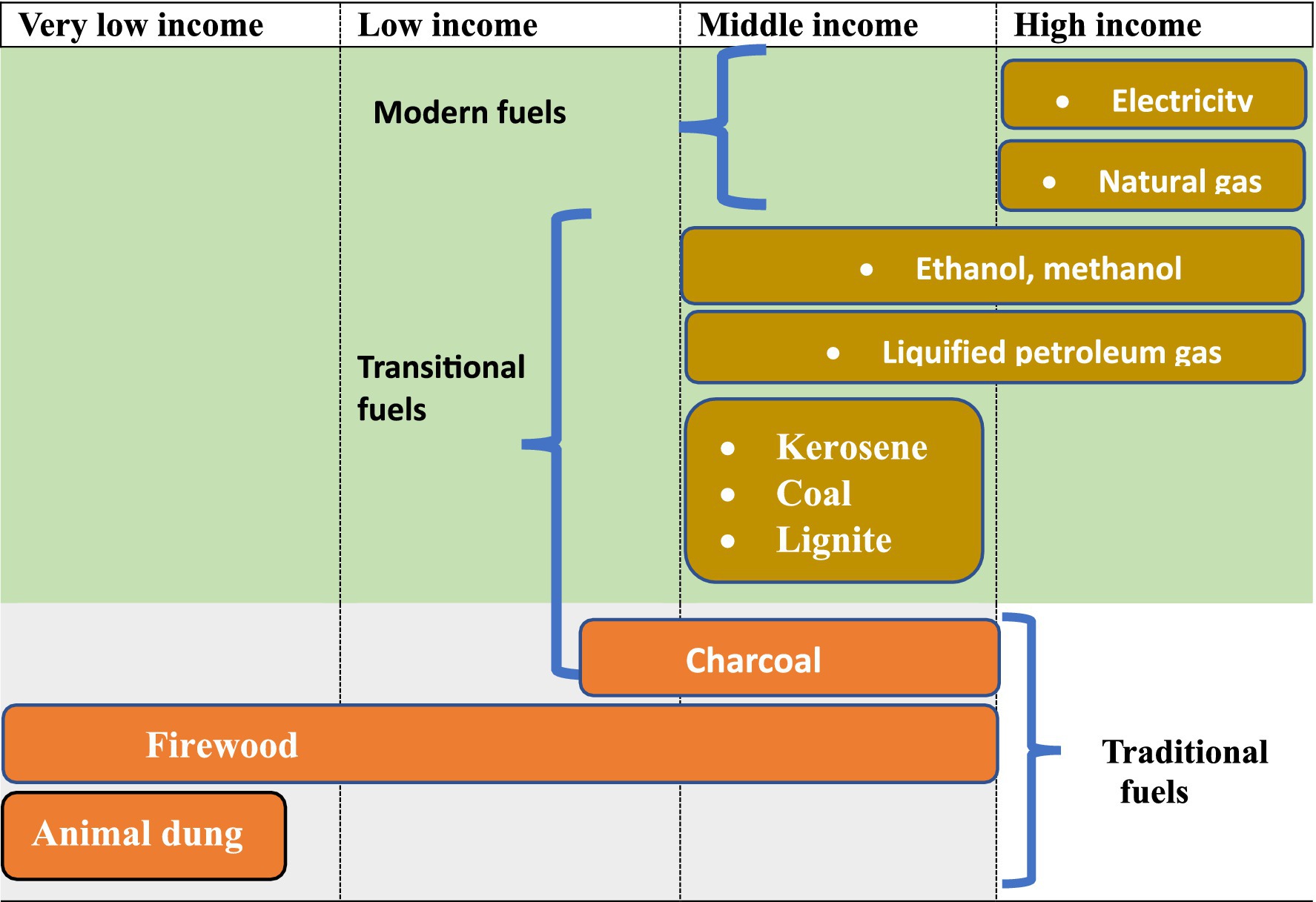
Figure 1. The process of energy transition (Van Der Kroon et al., 2013).
Energy ladder theory has met several criticisms. The ranking of wood fuel as inferior and therefore meant for the poor households has been criticized. Studies have shown that there are places where both the poor and the rich households use advanced fuels for cooking (Campbell et al., 2003; Iwona Bisaga, 2022). Masera et al. (2015) argue that households do not necessarily drop the unclean fuels but rather use them interchangeably. Despite the criticisms, undeniably the energy ladder remains a powerful approach that explains household’s energy transition.
2.2 Multi-tier framework
The traditional measure for energy access is binary in nature such that the household has or does not have access to it. This measurement ignores many other aspects that constitute energy access. Developed by Energy Sector Management Assistance Program (ESMAP), Multi-tier framework is designed to measure energy access based on usability (Worldbank, 2018). The multi-tier framework considers usability indicators to include: capacity, time in terms of hours, reliability, legal considerations, safety and affordability (Worldbank, 2018).
Operating from cooking fuels perspective, perceived satisfaction can be defined as the condition of taking an affective attitude toward a given fuel type for cooking. Therefore, the greater the degree of satisfaction for a particular cooking fuel, the higher the chances of its continued use. Whereas there are many factors that can be used to measure satisfaction, households consider the cost of fuel as key in determining its adoption (Monyei et al., 2019; Mainimo et al., 2022). Perceived satisfaction is commonly measured using affordability. Affordability is the ability of an individual or household to comfortably cover the costs of a product, service or living expenses. Affordability ratio is the portion of the monthly income spent on utility service including fuels (Fankhauser and Tepic, 2007).
Household expenditures instead of income was used to compute the affordability thresholds since the data on household’s expenditure captures almost all sources of revenue for households. According to Fankhauser and Tepic (2005), affordability is assessed by estimating the share of energy in the total household’s expenditure. Multitier framework sets affordability of fuel at less than 5% of the household income (Bhatia and Angelou, 2015). The Indian Council of Energy and Water (CEEW) framework on the other hand defines affordability of fuel to be at 6% of the household income (Jain et al., 2014, 2015). In other related studies (Sanga and Jannuzzi, 2005) the cost of cooking fuels should not exceed 10% of the total household annual expenditure. On average, spending 13–15% of the household income on energy fuels is a burden to poorer households (Jain, 2010). Scholars seem to agree that determining affordability ratio for fuel is not necessarily a straight forward task. This explains why governments and international financial institutions put in place ad hoc regulations on what makes up an acceptable level of utility expenditure (Fankhauser and Tepic, 2007). Considering the earnings and expenditure of households, the threshold for energy should not take more than 25% of the household income otherwise beyond 25% it becomes burdensome for the poorer households (Fankhauser and Tepic, 2007).
2.3 Review of literature on perceived satisfaction
Perceived satisfaction refers to an individuals’ subjective evaluation or judgment of the level of contentment or fulfilllment regarding a particular product, service or experience based on personal expectations, perceptions and desires. In marketing, satisfaction relates to how much the firm’s products or services are capable of fulfilling the customer needs and expectations (Giese et al., 2009; Pinem et al., 2019). Satisfaction is a comparison between performance and expectations (Oliver, 1980; Huang, 1997; Van Ryzin, 2004; Moliner et al., 2007). In the study of “usage activity, perceived usefulness and satisfaction, Hämäläinen et al. (2021) found that youth that were satisfied with the youth program were likely to commit to the program. This therefore implies that satisfaction plays a key role in one’s decision to commit or not to commit to any program.
Troncoso et al. (2013) conducted a study on improved cook stove adoption and impact assessment. They noted that households that did not frequently use improved cookstoves were less satisfied with them. This gives an indication that once a household perceives particular cookstove type as less satisfying, the lower the changes of using it for cooking. Xu and Ge (2020) who conducted a study on sustainable shifting from coal to gas in North China reported that resident satisfaction had a significant and positive effect on the resident trust and subsequent use of gas. This is in agreement with the earlier studies by Weitkamp et al. (2012). They reported the need for residents’ satisfaction with policy formulation and implementation before policy evaluation. This reflects on the importance and significance of satisfaction on decision making regarding the use different energy fuels.
The importance of satisfaction was also investigated by Nakano and Washizu (2018) in the study of efficient homes. They found out that residents accepted energy efficient homes only in areas where they were satisfied with. This implies that satisfaction played a key role in determining whether or not the residents will accept an energy efficient home based on their level of satisfaction with the area or location of the proposed energy efficient home. Kijazi and Kant (2011) evaluated the welfare functions of environmental amenities: a case of forest biomass in Tanzania. They noted that in the context of dependence on forest resources, households who depend largely on forest resources are satisfied with such resources. For such households, switching away from forest amenities including biomass cooking fuels becomes challenging because they perceive such amenities to be satisfying their cooking needs.
In related studies, Willand et al. (2015) after investigating the health impacts of residential energy efficiency interventions, noted that households that perceived the interventions as satisfactory in terms of heating, led to the use of more rooms in the households. This implies that had the interventions been perceived as less satisfying, the household occupants would still confine themselves in using one of fewer rooms. It is against such a background that this study proposes that perceived satisfaction influences household energy transition.
2.4 Review of literature on household energy transition
Household energy transition is characterized by the movement from unclean fuels usually traditional biomass and coal to cleaner modern fuels like electricity, natural gas, biogas and LPG (Leach, 1992; Sovacool et al., 2021). This movement is normally defined as climbing the energy ladder as household economic status improve. Households tend to make complete shift from unclean fuels to cleaner sources as soon as their incomes improve. Transition to cleaner fuels especially at the household level presents greater benefits. For instance Vo et al. (2024) argued that understanding the factors that promote household energy transition helps policy makers to develop appropriate strategies for mitigating climate change and global warming.
Household energy transition is critical for improving the health of the household occupants, more so women and girls who are directly involved in biomass collection and use. Maji et al. (2021) noted that women in households using biomass fuels for cooking had a higher probability (30–60%) of developing cough than men. They further noted that unlike the households using biomass fuels, the likelihood of developing cough for households using LPG was the same for both males and females. This implies that transition to cleaner fuels promotes good health for all gender.
Exploring different dimensions of household energy use is critical in designing and implementing strategies to facilitate transition to clean cooking fuels. Clean energy transition at household level is critical in addressing environmental concerns (World Health Organization, 2018). Through household energy transition, environment is protected through reduced harvesting of forest resources for fuel (Ghanbari and Kern, 2021). Further, the ecosystem is preserved since the habitat for wild life is protected (Ghanbari and Kern, 2021).
3 Materials and methods
3.1 Data and data sources
The study adopted a quantitative panel methodology. The Uganda National Panel Survey data covering three waves (2016/2017, 2017/2018 and 2019/2020) was used in this study. The choice of the panel data and more specifically the UNPS was based on two reasons. First, the phenomena under investigation is better analyzed using data collected over time since transition is a process rather than a one-off event. Secondly the UNPS data is rich and contains the key variables for the study. Stata package version 17.0 was used as a tool for analysis. The findings from the secondary panel data analysis were supplemented with the responses from qualitative responses.
3.2 Measuring perceived satisfaction
Household expenditures rather than income was used to compute the affordability thresholds since the data on household’s expenditure captures almost all sources of revenue for households. According to Fankhauser and Tepic (2005), affordability is assessed by estimating the share of energy in the total household’s expenditure as shown in Equation 1.
Table 1 shows the affordability thresholds and the corresponding assumptions.
3.3 Study variables
Type of fuel used for cooking was the dependent variable. The dependent variable being categorical in nature, was classified as; traditional, transition and modern fuels based on energy ladder theory (Hosier and Dowd, 1987). Firewood, animal dung and other plant wastes are grouped as traditional or primitive fuels. According to Islam et al. (2022) traditional or primitive one that release carbon dioxide and other polluting gasses to the atmosphere. Kerosene and efficient methods of burning wood fuel are classified as intermediate or transitional fuels while electricity and natural gas are classified as modern fuels (Leach, 1992; Karimu, 2015; Choumert-Nkolo et al., 2019). Fuels are classified as modern if they meet the emission targets in the World Health organization guidelines (WHO, 2022).
The predictive variables included; income threshold, age, education level, marital status and location of the household. Data analysis was done using STATA statistical package, version 17.0. An ordered logit regression model was used to estimate the effect of perceived satisfaction on household energy transition in Ugandan households. Ordered logit model, unlike other models was preferred because the data was ordinal in nature. Where there is some form of ordered progression, ordered logit becomes more appropriate for estimation (Grilli and Rampichini, 2021).
3.4 Estimation strategy
To study and model household energy transition, it was necessary to provide a method for grouping different fuels used by households for cooking into categories. Energy ladder framework was adopted and used to group the fuels into 3 distinct categories (i.e., j “0, 1 and 2”) where 0 is traditional fuels,1 is transitional fuels and 2 is modern fuels. This classification necessitated the application of the ordered logit model for analysis. Equation 2 shows the specification of the ordered logit model.
Where,
is the latent energy transition level for household ( = 0, 1, 2, … n);
is the vector of the observed explanatory variables for household (affordability threshold) that affect household energy transition; β is the matrix of the coefficients of the regression to be estimated (i.e., ) and denotes the error terms which should be independently and identically standard for logistic distribution.
The latent propensity is mapped to observed energy transition level through the threshold ( = − ∞ and = ∞) as shown in Equation 3.
The explanatory variables together with the control variables include; perceived satisfaction, household income, household size, marital status and education level of the household head. Where and were the thresholds values to be estimated together with β. The following probabilities were then predicted as shown in Equation 4;
Equation 4 can be rewritten in compact form as in Equation 5
Where is the cumulative function in Equation 5.
3.5 Empirical model
Where, ( = j) is the probability of choosing fuel in any of the two fuel categories other than the base category and ἱ is the individual household. Affordability threshold is the indicator for satisfaction, INCOM is the household income, HSIZE is the household size, is marital status of the household head while are the education level of the household head and error terms, respectively as shown in Equation 6.
4 Findings
4.1 Descriptive statistics
To determine the effect of perceived satisfaction on household energy transition, affordability was used as a measure of satisfaction. The main assumption is that households will be attracted to consume products of services that they can comfortably afford. For the purpose of this study, affordability thresholds were generated and presented in Table 2.
From Table 3, households within threshold one (1%) spent at least UGX: 1,681 on cooking fuels in 2016; UGX 1,169 in 2019 and UGX 1,169 in 2020. Households in level two (6%) spent at least UGX: 7,071, UGX: 6,987 and UGX: 7, 161 in the year 2016, 2019 and 2020, respectively. Households within threshold 3, spent UGX 8,178, UGX 8,478 and UGX 9099 in 2016, 2019 and 2020, respectively.
The statistics displayed in Table 3 have implications for household energy transition. The statistics demonstrate that most households have low income. This means that with low income fuel that has a direct monetary cost attached to it becomes a burden to a household. The low-income constraint therefore is a fundamental reason for low energy transition in Uganda.
4.2 Pre-estimation diagnostics
4.2.1 Hausman test
The Hausman test was used to decide which model between random and fixed effects was more appropriate to explain the relationship between the variables (Allison, 1994; Hardy and Bryman, 2009; Vijverberg, 2011; Sheytanova, 2014). The null hypothesis is that the preferred model is the random effect and the alternate hypothesis is that the preferred model is fixed effects as shown below:
H0: The appropriate model is random effects: there is no correlation between the error term and independent variables in the panel data.
H1: The appropriate model is fixed effects: the correlation between the error term and independent variables in the panel data model is statistically significant.
The results for the Hausman test are presented in section 3.
The chi-squared test is statistically significant at 0.05% significance level with Prob > chi2 = 0.0000). This implies that the null hypothesis is rejected in favor of the alternate hypothesis. Therefore, this study used the random effect model to estimate the effect of perceived satisfaction on household energy transition in Uganda.
4.2.2 Multicollinearity test
Before estimating the effect of perceived satisfaction on household energy transition, there was need to test for multicollinearity among the regressors. In this study, the VIF and correlation matrix were used to test for multicollinearity and the results are presented in Table 4.
The test results in Table 5 show a mean VIF of 1.33 with all the VIF values for the independent variables ranging between 1.0 to 1.6. The general rule of thumb is that the VIF values exceeding 10 are signs of serious multicollinearity among the regressors. Since the test results show a mean VIF of 1.33 which is far below 10, it implies absence of multicollinearity among the regressors. For the purposes of confirming the results obtained using the VIF, correlation matrix was used and the results are presented in Table 5.
The correlation results indicated that the correlation values for each independent variable was less than 0.58 0r (0.0 ≤ |r| ≤ 0.57), implying weak correlation between the regressors. This therefore indicates that the regressors used in the estimation showed no multicollinearity.
4.2.3 Normality
For meaningful conclusions, the assumption of normality should be respected. In that regard, this study used Shapiro–Wilk W test to test for normality and the following hypotheses were tested:
H0: The data is not statistically different from normal.
H1: The data is statistically different from normal.
The results are presented in Table 6.
The reference point is the W test statistic. The rule is that the closer the W statistic to 1, the more evidence there is, that the sample comes from a normally distributed population. The results of the Shapiro–Wilk W test for normal data shows that all the variables have normal distribution of the data.
4.3 Mean estimation of thresholds, income, age wage and household size
the average age of the household head is 47 years (see Table 7) and the average household size is 4.9 (approximately 5) members per household. The average monthly household income was UGX 624, 979.9. The amount of income reported is less than the international threshold of US$ 3.2. No wonder a majority of Ugandan household are said to leave below the poverty line. When household live below the poverty level, spending on clean cooking fuels becomes challenging.
4.4 The marginal estimated effect of perceived satisfaction on household energy transition in Uganda
To estimate the effect of perceived satisfaction on household energy transition in Uganda, an ordered logit model was used. The results are presented in Table 8.
The marginal effects of perceived satisfaction on household energy transition indicate that perceived satisfaction significantly affect household energy transition. Affordability was used to measure perceived satisfaction. Specifically, all the affordability threshold indicators positively influence the use of traditional fuels. For instance, allocating at least 1% of the income on cooking fuel increases the likelihood of consuming traditional fuel by 18.8%. On the other hand, allocating 1% of household income on cooking fuel reduces the likelihood of using transitional fuel and modern fuels by −17.7% and − 1.13%, respectively.
Findings also show that the likelihood of using traditional fuels increases by 5.2% when households allocate 6% of their income on cooking fuels. The same percentage (6%) reduces the likelihood of using transitional and modern fuels by −4.9% and − 0.31%, respectively. Finally, household spending at least 10% of their income on cooking fuel relative to other thresholds increases the likelihood of using traditional fuel for cooking by 0.45%. At the same time, allocating 10% of the household income on cooking fuel reduces the probability of transition to transition and modern fuels for cooking by-0.42% and − 0.27%, respectively.
These findings were supplemented by qualitative responses as below;
“….. the problem I see is not that food cooked by firewood is sweeter. In this area people only prefer smoking the water pot to get that smell. Why we do not use electricity for cooking is two reasons; one is that yaka meter runs very first when used for cooking and two we can take some days without having electricity then one can sleep hungry. Also, you see with little income you cannot buy clean energy. You can use that money to buy a sack of charcoal and you use for a month.” “….Now let me tell you when COVID-19 came even people who were using charcoal could no longer use charcoal. We all went back to collecting firewood. Even when you have money, there was no body transporting charcoal from the village to towns. It was very difficult time. There was no difference between those who had money from those who did not have because there was no supply of alternatives like liquified petroleum gas”.
Among the control variables, income, age and marital status of the household head were statistically significant. Specifically, a 1% increase in income leads to 8.34% decrease in the use of traditional fuel for cooking but increases the likelihood of transition to transitional and modern fuels by 7.84 and 0.5%, respectively. This result agrees with the assertion of the energy ladder theory. The energy ladder hypothesis highlights that with an increase in household income, households progress through the energy ladder. They abandon the traditional fuels and instead adopt and use clean cooking fuels.
Household size is also statistically significant and positive for traditional fuels but negative for transitional and modern fuels. This implies that an increase in the household occupants by one person is associated with a 2% increase in the use of traditional fuels. On the other hand, an increase on the number of occupants by one person reduces the likelihood of using transitional and modern fuels for cooking by −1.9% and − 0.12%, respectively. These results mean that as the number of household members increase, households may not be able to afford cleaner fuels and instead revert to use dirty and cheaper fuel sources.
In terms of the age of the household head, the findings show that an increase in the age of the household head by 1 year increases the likelihood of using traditional fuels for cooking by 0.21%. On the other hand, an increase on the age of the household head by 1 year reduces the likelihood of transitioning to both transitional and modern fuels by −0.1%.
The results further showed that location of the household (urban or rural) have a significant effect on household energy transition. Household being in urban relative to rural area reduces the likelihood of using traditional fuels by −12.8% but increases the likelihood of transition to transitional and modern cooking fuels by 12 and 0.8%, respectively. This implies that households located in urban are more likely to transition to modern cooking fuels compared to those in rural setting.
Household being headed by single head reduced the likelihood of using traditional fuels by −12.7% but increases the probability of switching to transition fuels and modern fuels by 12 and 0.77%, respectively. Single headed households normally have fewer household members thus making it possible to prepare few meals that do not consume a lot of energy. Furthermore, singles in most cases are relatively young people who have just completed school and gained employment. This means that they have relatively higher disposable income that can be used to acquire clean cooking fuels as opposed to households with numerous numbers of occupants.
4.5 Robustness check
In this section, we test whether the regression results are stable and robust to the initial model specification. To do this, we introduce two more variables which might influence household energy transition decisions; kitchen location and wage employment. Prior studies (Bhatia and Angelou, 2015; Ochieng et al., 2020; Ravindra et al., 2021) have reported the impact of kitchen type and or location and the type of employment on household cooking fuel choices. The purpose of including these two variables is to check whether the affordability remains significant after other variables which can potentially have an effect on energy transition are introduced into the model. The following alternative model was estimated and the results are presented in Table 9.
Where; HET – household energy transition, INCOM – household income, Mstatus – marital status of the household head, EDLEV – Education level of the household head, Klocation – Kitchen location, lwage – wage employment and - error term.
The results obtained from the alternative model with new variables included are presented in Table 9. The findings show that affordability thresholds remain statistically significant at 5% significant level. This implies that the results from the original model are robust and can be relied upon in making policies regarding household energy transition in Uganda.
5 Discussion
The study findings reveal the significance of perceived satisfaction in transition of households to using modern cooking fuels. It means that households only adopt and use fuels they are satisfied with in terms of affordability. The implication is that households continue to use traditional fuels because they can afford and abandon cleaner or modern fuels because they cannot afford. These findings agree with what is reported by earlier scholars. For instance, Alem et al. (2013) noted that affordability and cultural preference are the main determinants of household transition. Similar findings were reported by Swain and Mishra (2020) Swain and Mishra (2021). They noted that increased use of unclean fuel is endearing in rural areas due to low access and the cost implication associated with modern fuels. Different households are satisfied if fuel improves the speed of cooking, others consider reduced smoke and quality of the meals. However satisfaction with the cost (affordability) is a critical determinant for household energy transition (Baquié and Urpelainen, 2017).
Moreover, the cost of clean fuel alternatives can be less of a burden to wealthier households because they can afford. On the other hand, firewood dominantly used in poor households simply because in most cases it is collected free from the bushes around. The findings also agree with those of Gebreegziabher et al. (2018). They emphasized that satisfaction with the particular fuel stove plays key role in adoption of such a fuel. This means that if households are satisfied with the cooking fuel, then they see a reason to transition to using such fuel. It is clear that consumer satisfaction is a vital concern especially for improving and maintaining consumer loyalty (Kerste et al., 2011).
In area of household energy transition, Sustainable Development Goal – SDG 7 requires that all households have access to affordable, reliable, sustainable and modern energy. Therefore, ensuring that households are satisfied and willing to use cleaner fuels for cooking is central in achieving Sustainable Development goals. The findings indicate that a majority of the households lie within lower income threshold. In order to promote and expand access to clean cooking, there is need to tackle poverty, improve the income levels of households. As a result, households can be able to use cleaner fuels and this contributes significantly to the achievement of the sustainable development goals target for the country.
In relation to theory, energy ladder theory argues that households with low income levels are likely to choose biomass while the rich households will prefer expensive but cleaner fuel sources for cooking. The study finding conforms to this narrative and support the energy ladder hypothesis. The results showed that households that spent about 1% of their income on energy fuels used traditional biomass for cooking. Traditional fuel despite of the hidden consequences such as health related costs and time wasted during collection, is perceived as affordable due to low or no direct cost (Heltberg, 2004, 2005). As a result, households in poor economic state will adopt traditional fuels for cooking. One of the respondents in semi-urban area in Mukono in an interview said; “…. Why would I spend money to buy energy fuel yet there is free of charge firewood all around my household?” This is a testament to the fact that households with low income will always settle for biomass which has no direct cost attached to it.
These results also agree with what the earlier scholars reported. For instance Viswanathan and Kavi Kumar (2005) noted that energy transition in rural households of south Africa was largely driven by income. There is also a concern of household energy transition being affected by the variation (Viswanathan and Kavi Kumar, 2005) in household income. When the household income increases at one point, they choose cleaner fuels and when income drops, they are forced to fall back to traditional fuels. This implies that improving the incomes of households is vital for household energy transition. This finding is supported by extant literature from other scholars. For example, Katutsi et al. (2020) reported that as the head of the household grows older, they tend to incline more to using traditional fuel. In most cases as household heads grow older, their capacity to earn as well lowers. This means that meeting the cost of clean cooking fuel becomes a burden hence reverting to unclean fuels. Katutsi et al. (2020) further noted that the older one gets, the lower the savings and as such households headed by older heads tend to stick with traditional fuels as opposed to modern fuels. The study also found out that location of the household whether rural or urban had an influence on household energy transition. Households located in urban areas were more likely to adopt cleaner cooking fuels than those in rural areas. This could partly be explained by the fact that urban dwellers can easily access the clean cooking alternatives compared to rural dwellers. This finding supported by earlier scholarly work. For instance Oyedele (2023) noted that a majority of households using traditional fuels for cooking are found in rural areas.
6 Conclusion
This paper assessed the effect of perceived satisfaction on household energy transition in Ugandan households. Perceived satisfaction was measured by affordability. The study findings established that affordability has a significant effect on household energy transition in Ugandan households. Drawing from the fundamentals of energy ladder theory, households progress from traditional polluting fuels to cleaner and more advanced fuels as their socio-economic status improves. In other words, the theory suggests an upward movement from biomass-based cooking fuels to cleaner ones. Several theoretical, policy and practically implications can be drawn from this study as discussed in section 6.
6.1 Study implications
6.1.1 Theoretical implications
The study used The Energy Ladder theory and the Multi-tier Framework (MTF) to explain how perceived satisfaction can influence household energy transition in Uganda. As a contribution, the study combines multi-tier framework with energy ladder theory to explain the relationship between perceived satisfaction and household energy transition in Uganda. The study used a theoretical pluralism approach based on the energy ladder theory and multi-tier framework to provide a more comprehensive and nuanced understanding of perceived satisfaction and household energy transition and its antecedents in Uganda.
This study presents empirical evidence of the relevance of perceived satisfaction from the energy ladder theory and multi-tier framework in explaining household energy transition. Conceptualizing perceived satisfaction using affordability, the cost of energy fuel plays a key role in satisfaction. From energy ladder perspective, moving up the ladder involves not only the cost of fuel but also initial investments in terms of cooking technologies for modern fuels. Some scholars have already reported energy access (Puzzolo et al., 2016), cultural considerations as antecedents of perceived satisfaction. This adds to the findings of the previous scholars by reporting that affordability is critical antecedent of satisfaction that can drive household energy transition.
6.1.2 Practical implications
The study findings show that affordability is crucial for the transition to take place since cleaner sources have a cost attached to them. For instance, the findings indicated that if households spent at least 1% of their income on cooking fuels, the likelihood of choosing traditional fuel increased by 18.8%. Similarly, the likelihood of switching to transitional and modern fuels decreased by −17.7% and − 1.1%, respectively. Beyond having a significant effect on household energy transition, these findings suggest that because of the cost implications, households allocating 1% of their income on cooking fuels are less likely to switch to cooking fuels. This means that such households are satisfied with traditional fuels that they can afford, as opposed to transitional and modern fuels that are beyond what their income can enable them to attain.
The study findings further indicate that the higher the percentage of income allocated for cooking fuels, the more the household’s dependency on traditional fuels reduces. For instance, when households allocate 6% rather than 1% of their income on cooking fuels, the likelihood of relying on traditional fuels for cooking is 5.2%, compared to 18.8% when they allocate only 1%. This likelihood of relying on traditional fuels even reduces further if households allocate 10% of their income on cooking fuels. It means that the likelihood of relying on traditional fuels for cooking is only 4.5%, compared to 5.2 when only 6% of the income is allocated for cooking fuels. Based on these results, the study concludes that empowering households economically (improving their incomes) is crucial for household energy transition. Furthermore, with empowered households capable of using clean cooking fuels, the question of cutting forests for firewood is reduced. In addition, with the reduced use of polluting fuels for cooking among households, the rate of green gas emissions is reduced thus contributing to climate change control.
6.1.3 Policy implications
The study findings established a significant association between perceived satisfaction and household energy transition. The significant association between affordability of the cooking fuels and household energy transition offers policy direction to government and other agencies working with energy sector. Policies to subsidize cleaner fuels and make them affordable for households can help households adopt and switch to cleaner options. Furthermore, policies to ensure payment of cleaner alternative and associated technologies on an installment basis, more so for poorer households bring flexibility and make the fuel and the cooking technologies affordable.
6.1.4 Areas for future research
In this study, quantitative secondary data was used for analysis. The findings from quantitative data were supplemented with qualitative responses from few selected households. Future studies may consider using primary qualitative data to understand households’ perceptions about energy transition in Uganda.
Data availability statement
The raw data supporting the conclusions of this article will be made available by the authors, without undue reservation.
Author contributions
JE: Conceptualization, Data curation, Formal analysis, Writing – original draft, Writing – review & editing. JN: Supervision, Validation, Data curation, Writing – original draft. MA: Conceptualization, Supervision, Validation, Writing – review & editing. FB: Writing – review & editing. RA: Methodology, Supervision, Validation, Writing – review & editing. MN: Conceptualization, Methodology, Supervision, Writing – review & editing.
Funding
The author(s) declare that no financial support was received for the research, authorship, and/or publication of this article.
Conflict of interest
The authors declare that the research was conducted in the absence of any commercial or financial relationships that could be construed as a potential conflict of interest.
Publisher’s note
All claims expressed in this article are solely those of the authors and do not necessarily represent those of their affiliated organizations, or those of the publisher, the editors and the reviewers. Any product that may be evaluated in this article, or claim that may be made by its manufacturer, is not guaranteed or endorsed by the publisher.
References
Allison, P. D. (1994). Using panel data to estimate the effects of events. Sociol. Methods Res. 23, 174–199. doi: 10.1177/0049124194023002002
Amoah, S. T. (2019). Determinants of household’s choice of cooking energy in a global south city. Energ. Buildings 196, 103–111. doi: 10.1016/j.enbuild.2019.05.026
Bamwesigye, D., Kupec, P., Chekuimo, G., Pavlis, J., Asamoah, O., Darkwah, S. A., et al. (2020). Charcoal and wood biomass utilization in Uganda: the socioeconomic and environmental dynamics and implications. Sustainability (Switzerland) 12, 1–18. doi: 10.3390/su12208337
Baquié, S., and Urpelainen, J. (2017). Access to modern fuels and satisfaction with cooking arrangements: survey evidence from rural India. Energy Sustain. Dev. 38, 34–47. doi: 10.1016/j.esd.2017.02.003
Bhatia, M., and Angelou, N. (2015). Beyond connections: energy access redefined. ESMAP Tech. Rep. 8, 1–244. doi: 10.1596/24368
Campbell, B. M., Vermeullen, S. J., Mangono, J. J., and Mabugu, R. (2003). The energy transition in action: urban domestic fuel choices in a changing Zimbabwe. Energy Policy 31, 553–562. doi: 10.1016/S0301-4215(02)00098-8
Casati, P., Fumagalli, E., Baldi, D., and Moner-Girona, M. (2024). Understanding the drivers of electricity access and willingness to pay for reliable electricity in African refugee settlements: evidence from Zambia, Malawi, and Uganda. Energy Res. Soc. Sci. 113:103546. doi: 10.1016/j.erss.2024.103546
Choumert-Nkolo, J., Combes Motel, P., and Le Roux, L. (2019). Stacking up the ladder: a panel data analysis of Tanzanian household energy choices. World Dev. 115, 222–235. doi: 10.1016/j.worlddev.2018.11.016
Fankhauser, S., and Tepic, S. (2005). “Can Poor Consumers Pay for Energy and Water? – An Affordability Analysis for Transition Countries”, EBRD Working Paper, No. 92, London.
Fankhauser, S., and Tepic, S. (2007). Can poor consumers pay for energy and water? An affordability analysis for transition countries. Energy Policy 35, 1038–1049. doi: 10.1016/j.enpol.2006.02.003
Frankowska, A., Rivera, X. S., Bridle, S., Kluczkovski, A. M. R. G., Tereza da Silva, J., Martins, C. A., et al. (2020). Impacts of home cooking methods and appliances on the GHG emissions of food. Nat. Food 1, 787–791. doi: 10.1038/s43016-020-00200-w
Gebreegziabher, Z., Beyene, A. D., Bluffstone, R., Martinsson, P., Mekonnen, A., and Toman, M. A. (2018). Fuel savings, cooking time and user satisfaction with improved biomass cookstoves: evidence from controlled cooking tests in Ethiopia. Resour. Energy Econ. 52, 173–185. doi: 10.1016/j.reseneeco.2018.01.006
Ghanbari, S., and Kern, C. C. (2021). Fuelwood harvest and no harvest effects on forest composition, structure, and diversity of arasbaran forests–a case study. Forests 12:1631. doi: 10.3390/f12121631
Giese, J. L., Giese, J. L., Cote, J. A., and Cote, J. A. (2009). Defining consumer satisfaction. Acad. Mark. Sci. Rev. 1, 272–278.
Gould, C. F., and Urpelainen, J. (2018). LPG as a clean cooking fuel: adoption, use, and impact in rural India. Energy Policy 122, 395–408. doi: 10.1016/j.enpol.2018.07.042
Grilli, L., and Rampichini, C. (2021). Ordered logit model. In: Encyclopedia of Quality of Life and Well-Being Research. Berlin: Springer.
Hämäläinen, T., Kaipainen, K., Lappalainen, P., Puolakanaho, A., Keinonen, K., Lappalainen, R., et al. (2021). Usage activity, perceived usefulness, and satisfaction in a web-based acceptance and commitment therapy program among Finnish ninth-grade adolescents. Internet Interv. 25:100421. doi: 10.1016/j.invent.2021.100421
Heltberg, R. (2004). Fuel switching: evidence from eight developing countries. Energy Econ. 26, 869–887. doi: 10.1016/j.eneco.2004.04.018
Heltberg, R. (2005). Factors determining household fuel choice in Guatemala. Environ. Dev. Econ. 10, 337–361. doi: 10.1017/S1355770X04001858
Hiemstra-van der Horst, G., and Hovorka, A. J. (2008). Reassessing the “energy ladder”: household energy use in Maun, Botswana. Energy Policy 36, 3333–3344. doi: 10.1016/j.enpol.2008.05.006
Hosier, R. H., and Dowd, J. (1987). Household fuel choice in Zimbabwe. An empirical test of the energy ladder hypothesis. Resour. Energy 9, 347–361. doi: 10.1016/0165-0572(87)90003-X
Huang, H. H. (1997). Using expectation disconfirmation theory to explore the relationship satisfaction between businesses to businesses. 7. Available at: https://www.impgroup.org/uploads/papers/8458.pdf.
Islam, S., Upadhyay, A. K., Mohanty, S. K., Pedgaonkar, S. P., Maurer, J., and O’Donnell, O. (2022). Use of unclean cooking fuels and visual impairment of older adults in India: a nationally representative population-based study. Environ. Int. 165:107302. doi: 10.1016/j.envint.2022.107302
Jahanshahi, A., Gashti, M. A., Mirdamadi, S., Nawaser, K., and Khaksar, S. M. S. (2011). Study the effects of customer service and product quality on customer satisfaction and loyalty. International journal of humanities and social. Science 1, 253–260.
Jain, G. (2010). Energy security issues at household level in India. Energy Policy 38, 2835–2845. doi: 10.1016/j.enpol.2010.01.016
Jain, A., Choudhury, P., and Ganesan, K. (2015). Clean, affordable and sustainable cooking energy for India. Ceew, February, No. 72. Available at: http://ceew.in/pdf/ceew-clean-affordable-and-sustainable-cooking.pdf.
Jami, J. (2018). The dilemma of classification of income levels in social research. NEHU J. 16, 19–30.
Jürisoo, M., Serenje, N., Mwila, F., Lambe, F., and Osborne, M. (2019). Old habits die hard: using the energy cultures framework to understand drivers of household-level energy transitions in urban Zambia. Energy research and social. Science 53, 59–67. doi: 10.1016/j.erss.2019.03.001
Kansiime, W. K., Mugambe, R. K., Atusingwize, E., Wafula, S. T., Nsereko, V., Ssekamatte, T., et al. (2022). Use of biomass fuels predicts indoor particulate matter and carbon monoxide concentrations; evidence from an informal urban settlement in Fort Portal city, Uganda. BMC Public Health 22, 1–12. doi: 10.1186/s12889-022-14015-w
Karimu, A. (2015). Cooking fuel preferences among Ghanaian households: an empirical analysis. Energy Sustain. Dev. 27, 10–17. doi: 10.1016/j.esd.2015.04.003
Katutsi, V., Dickson, T., and Migisha, A. G. (2020). Drivers of fuel choice for cooking among Uganda’s households. Open J. Energy Effic. 9, 111–129. doi: 10.4236/ojee.2020.93008
Kerste, M., Rosenboom, N., Sikken, B. J., and Weda, J. (2011). Financing sustainability: insights for investors, corporate executives, and policymakers. In: Social Science Research Network. Available at: http://papers.ssrn.com/sol3/papers.cfm?abstract_id=1893373.
Kijazi, M. H., and Kant, S. (2011). Evaluation of welfare functions of environmental amenities: a case of forest biomass fuels in Mount Kilimanjaro, Tanzania. Ecol. Econ. 72, 129–139. doi: 10.1016/j.ecolecon.2011.09.016
Kotler, P., Wong, V., Saunders, J., and Armstrong, G. (2005). Principles of marketing. fourth European edition, vol. 38. London, UK: Pearson.
Leach, G. (1992). The energy transition. Energy Policy 20, 116–123. doi: 10.1016/0301-4215(92)90105-B
Mainimo, E. N., Okello, D. M., Mambo, W., and Mugonola, B. (2022). Drivers of household demand for cooking energy: a case of Central Uganda. Heliyon 8:e09118. doi: 10.1016/j.heliyon.2022.e09118
Maji, P., Mehrabi, Z., and Kandlikar, M. (2021). Incomplete transitions to clean household energy reinforce gender inequality by lowering women’s respiratory health and household labour productivity. World Dev. 139:105309. doi: 10.1016/J.WORLDDEV.2020.105309
Malakar, Y., Greig, C., and van de Fliert, E. (2018). Resistance in rejecting solid fuels: beyond availability and adoption in the structural dominations of cooking practices in rural India. Energy Res. Soc. Sci. 46, 225–235. doi: 10.1016/j.erss.2018.07.025
Masera, O. R., Bailis, R., Drigo, R., Ghilardi, A., and Ruiz-Mercado, I. (2015). Environmental burden of traditional bioenergy use. Annu. Rev. Environ. Resour. 40, 121–150. doi: 10.1146/annurev-environ-102014-021318
Ministry of Local Government . (2021). Implementation guidelines for parish development model implementation guidelines for parish development model ministry of local government the Republic of Uganda. Available at: https://www.masindi.go.ug/sites/default/files/Implementation_Guidelines_for_FOR__PARISH_MODEL_OPERATION%5B1%5D.pdf%0Ahttps://www.kasese.go.ug/wp-content/uploads/2021/09/Implementation-Guidelines-for-FOR-PARISH-MODEL-OPERATION.pdf.
Moliner, M. A., Sánchez, J., Rodríguez, R. M., and Callarisa, L. (2007). Perceived relationship quality and post-purchase perceived value: an integrative framework. In. Eur. J. Mark. 41, 1392–1422. doi: 10.1108/03090560710821233
Monyei, C. G., Oyedele, L. O., Akinade, O. O., Ajayi, A. O., Ezugwu, A. E., Akpeji, K. O., et al. (2019). An income-reflective scalable energy level transition system for low/middle income households. Sustain. Cities Soc. 45, 172–186. doi: 10.1016/j.scs.2018.10.042
Nakano, S., and Washizu, A. (2018). Acceptance of energy efficient homes in large Japanese cities: understanding the inner process of home choice and residence satisfaction. J. Environ. Manag. 225, 84–92. doi: 10.1016/j.jenvman.2018.07.082
National Planning Authority (NDPIII) . (2020). Third National Development Plan (NDPIII) 2020/21-2024/25. National Planning Authority, January, pp. 1–310. Available at: http://envalert.org/wp-content/uploads/2020/06/NDP-3-Finale.pdf
Ndunguru, E., and Lema, G. (2021). Factors that affect the adoption of liquefied Petroleum gas in Kinondoni Municipality, Tanzania. J. Geogr. Assoc. Tanzania 40, 120–136. doi: 10.56279/jgat.v40i1.22
Ochieng, C. A., Zhang, Y., Nyabwa, J. K., Otieno, D. I., and Spillane, C. (2020). Household perspectives on cookstove and fuel stacking: a qualitative study in urban and rural Kenya. Energy Sustain. Dev. 59, 151–159. doi: 10.1016/j.esd.2020.10.002
Oliver, R. L. (1980). A cognitive model of the antecedents and consequences of satisfaction decisions. J. Mark. Res. 17:460. doi: 10.2307/3150499
Oyedele, O. (2023). Determinants of household cooking energy choice: are such choices influenced by health outcomes? Int. J. Energy Econ. Policy 13, 553–564. doi: 10.32479/ijeep.13977
Pinem, S., Husnan, L. H., and Handayani, B. R. (2019). The impact of service quality on customer loyalty with moderating effect of customer satisfaction in Ditlantas Polda Ntb. Russ. J. Agric. Soc. Econ. Sci. 9, 17–26. doi: 10.18551/rjoas.2019-09.02
Puzzolo, E., Pope, D., Stanistreet, D., Rehfuess, E. A., and Bruce, N. G. (2016). Clean fuels for resource-poor settings: a systematic review of barriers and enablers to adoption and sustained use. Environ. Res. 146, 218–234. doi: 10.1016/j.envres.2016.01.002
Ravindra, K., Kaur-Sidhu, M., and Mor, S. (2021). Transition to clean household energy through an application of integrated model: ensuring sustainability for better health, climate and environment. Sci. Total Environ. 775:145657. doi: 10.1016/j.scitotenv.2021.145657
Sanga, G. A., and Jannuzzi, G. D. M. (2005). Impacts of efficient stoves and cooking fuel substitution in family expenditures of urban households in Dar Es Salaam, Tanzania. Energy 2:11.
Schlag, N., and Zuzarte, F. (2008). Market barriers to clean cooking fuels in sub-Saharan Africa: a review of literature. Fuel, April, 1–21. Available at: http://sei-international.org/mediamanager/documents/Publications/Climate/market_barriers_clean_cooking_fuels_21april.pdf.
Sheytanova, T. (2014). The accuracy of the Hausman test in panel data: a Monte Carlo study. pp. 1–53.
Sovacool, B. K., Hess, D. J., and Cantoni, R. (2021). Energy transitions from the cradle to the grave: a meta-theoretical framework integrating responsible innovation, social practices, and energy justice. Energy Res. Soc. Sci. 75:102027. doi: 10.1016/j.erss.2021.102027
Stanistreet, D., Hyseni, L., Puzzolo, E., Higgerson, J., Ronzi, S., Anderson, R., et al. (2019). Barriers and facilitators to the adoption and sustained use of cleaner fuels in Southwest Cameroon: situating “lay” knowledge within evidence-based policy and practice. Int. J. Environ. Res. Public Health 16:4702. doi: 10.3390/ijerph16234702
Swain, S. S., and Mishra, P. (2020). Determinants of adoption of cleaner cooking energy: experience of the Pradhan Mantri Ujjwala Yojana in rural Odisha, India. J. Clean. Prod. 248:119223. doi: 10.1016/j.jclepro.2019.119223
Swain, S. S., and Mishra, P. (2021). How does cleaner energy transition influence standard of living and natural resources conservation? A study of households’ perceptions in rural Odisha, India. Energy 215:119135. doi: 10.1016/j.energy.2020.119135
Troncoso, K., Armendáriz, C., and Alatorre, S. (2013). Improved cook stove adoption and impact assessment: a proposed methodology. Energy Policy 62, 637–645. doi: 10.1016/j.enpol.2013.07.074
UBOS-UNHS . (2020). Uganda National Survey Report 2019/2020 released – Uganda bureau of statistics. Available at: https://www.ubos.org/uganda-national-survey-report-2019-2020-released/.
Van Der Kroon, B., Brouwer, R., and Van Beukering, P. J. H. (2013). The energy ladder: theoretical myth or empirical truth? Results from a meta-analysis. Renew. Sust. Energ. Rev. 20, 504–513. doi: 10.1016/j.rser.2012.11.045
Van Ryzin, G. G. (2004). Expectations, performance, and citizen satisfaction with urban services. J. Policy Anal. Manage. 23, 433–448. doi: 10.1002/pam.20020
Vijverberg, W. (2011). Testing for IIA with the Hausman-Mcfadden test. SSRN Electron. J. 5826:845. doi: 10.2139/ssrn.1882845
Viswanathan, B., and Kavi Kumar, K. S. (2005). Cooking fuel use patterns in India: 1983-2000. Energy Policy 33, 1021–1036. doi: 10.1016/j.enpol.2003.11.002
Vo, D. H., Vo, A. T., and Ho, C. M. (2024). Understanding the characteristics of the household energy transition in a developing country. Heliyon 10:e23977. doi: 10.1016/j.heliyon.2024.e23977
Weitkamp, G., Van den Berg, A. E., Bregt, A. K., and Van Lammeren, R. J. A. (2012). Evaluation by policy makers of a procedure to describe perceived landscape openness. J. Environ. Manag. 95, 17–28. doi: 10.1016/j.jenvman.2011.09.022
WHO . (2022). Compendium of WHO and other UN guidance on health and environment: 2022 update. WHO Fact Sheet, 2019, No. 5. Available at: https://www.who.int/en/news-room/fact-sheets/detail/arsenic.
Willand, N., Ridley, I., and Maller, C. (2015). Towards explaining the health impacts of residential energy efficiency interventions - a realist review. Part 1: pathways. Soc. Sci. Med. 133, 191–201. doi: 10.1016/j.socscimed.2015.02.005
World Health Organization . (2018). Opportunities for transition to clean household energy: application of the WHO household energy assessment rapid tool (HEART) in India. Available at: https://apps.who.int/iris/bitstream/handle/10665/274280/9789241513999-eng.pdf?sequence=1&isAllowed=y.
Worldbank . (2018). Tracking SDG 7.1 with the multi- tier framework measuring energy access. Available at: https://sustainabledevelopment.un.org/content/documents/24126pb15_cover.pdf%0Ahttps://sustainabledevelopment.un.org/content/documents/17565PB18.pdf.
Keywords: satisfaction, perceived, traditional fuels, transitional fuels, modern fuels
Citation: Elasu J, Ntayi JM, Adaramola MS, Buyinza F, Atukunda R and Ngoma M (2024) Perceived satisfaction and household fuel transition: evidence from Ugandan households. Front. Sustain. 5:1404806. doi: 10.3389/frsus.2024.1404806
Edited by:
Maria Alzira Pimenta Dinis, Fernando Pessoa University, PortugalReviewed by:
Martinson Ankrah Twumasi, Sichuan Agricultural University, ChinaSuresh Jain, Indian Institute of Technology Tirupati, India
Copyright © 2024 Elasu, Ntayi, Adaramola, Buyinza, Atukunda and Ngoma. This is an open-access article distributed under the terms of the Creative Commons Attribution License (CC BY). The use, distribution or reproduction in other forums is permitted, provided the original author(s) and the copyright owner(s) are credited and that the original publication in this journal is cited, in accordance with accepted academic practice. No use, distribution or reproduction is permitted which does not comply with these terms.
*Correspondence: Joseph Elasu, ZWxhc3Uuam9zZXBoQG11YnMuYWMudWc=
 Joseph Elasu
Joseph Elasu Joseph Mpeera Ntayi
Joseph Mpeera Ntayi Muyiwa S. Adaramola1
Muyiwa S. Adaramola1 Faisal Buyinza
Faisal Buyinza